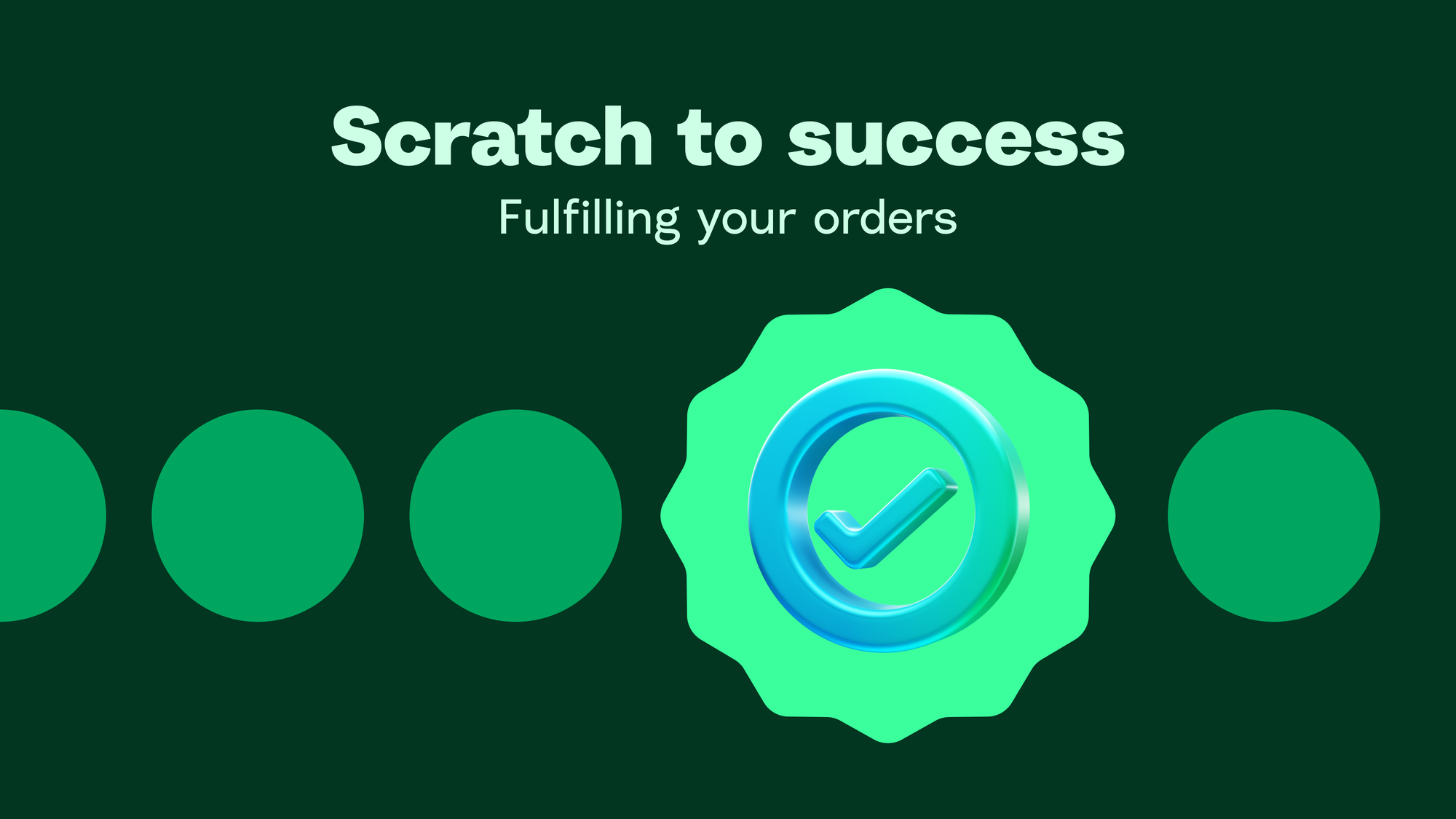Master the art of fulfilling orders | Scratch to success

Now that you’ve created your strategy and set up your shop, you need to consider how you will fulfil your orders. While you have already made the sale, the post-purchase experience of how you fulfil the order can define a shopper's impression of your brand.
Our Ultimate Shopping Survey revealed that 'receiving my purchase on time' was the second most popular reason for shoppers to return to the same brand, behind the product itself.
When brands get it right, it can lead to great success. Amazon built their entire business model around customer satisfaction, and prompt delivery times were a big part of that process.
Customers now expect top service every time they order.
It's important to note that great order fulfilment is more than just next-day delivery. You can use plenty of tactics to improve the shopping experience without decreasing the delivery time. Shoppers will always buy quality products no matter what, but they will be less likely to purchase again if they encounter issues after they purchase.
In this guide we're going to break down what it takes to effectively fulfil orders to keep your shoppers coming back for more.
- Storage
- Packaging
- Shipping
- Returns
Storage
Starting with the basics, there are three ways to manage your stock. Bear in mind that needs can vary greatly between industries. For example, food needs to be temperature-controlled, and if your product contains batteries, there are strict storage regulations.
| Business Size | Storage solution | Description |
|---|---|---|
| Small | Self storage |
Using your existing premises to store your stock. Ideal for small brands that have limited product ranges. |
| Medium | Third party logistics (3PL) |
A third party company can manage your stock for a fee. Ideal for scaling businesses who demand more space but cannot justify the cost of leasing and staffing a warehouse. |
| Large | Warehouse |
Rent your own specialist storage facility. This is an expensive solution suitable for larger brands with large product ranges. |
Classifying your inventory
While you may start out with a limited number of products to sell, it’s important to implement good processes so that you can effectively manage your stock as you grow.
Keeping track of your inventory is vital behind-the-scenes work needed to ensure your customers' seamless shopping experience. Yes, it seems mundane, but lousy inventory management can lead to loss of sales, increased storage costs, and deeply frustrated customers.
It’s also important to record all your product's weights and dimensions, which will help you calculate your shipping costs.
Which one should I use?
| Method | Description | User case |
|---|---|---|
| First in, first out (FIFO) | Oldest inventory is sold first, making sure that you have a regular rotation of stock. |
Any sized brand. Especially for products with limited shelf life. |
| ABC Analysis | Value based classification, with A being high value and C being low value. |
Brands with a large variety of products. |
| Economic Order Quantity (EOQ) | Precise calculation that factors in ordering costs, carrying costs and demand variability. EOQ focuses on the most efficient classification depending on the product. |
Large brands that find value in optimising small margins. |
| Just in time (JIT) | Classification method that focuses on minimising holding costs by adjusting the stock depending on demand. |
Smaller brands that want to reduce storage costs. |
Packaging
While packaging is rarely a topic of conversation around the dinner table, it is essential in the world of ecommerce.
Apple might be responsible for the packaging revolution by creating futuristic white boxes that satisfyingly reveal your brand-new phone. But it's not that difficult to replicate for normal brands and can be a small investment for a vast reward.
A great example is Jumnah, a refurbished tech brand based in the UAE. Instead of putting the phones in DHL sleeves, they created a custom box to replicate the experience you get when buying a phone for new.

Shipping
You can break down the success of your ecommerce shipping strategy into three steps. These stages all need to work in tandem to ensure that your customers have a seamless shopping experience from the moment they buy to the moment they receive their order.
- Choose a shipping partner
- Set your shipping rates
- Communication
Choose a shipping partner
The first step in providing a good shipping experience is selecting a partner who will fulfil your orders effectively and within budget.
Saudi Arabia
We've collected a few options, but it's important to note that no one type fits all. Each delivery partner has different specialties, and you should pick one based on your needs and budget.
Set your shipping rates
The key question is if you want to offer free shipping or add on the shipping cost as an extra charge.
The trade-off is that offering free shipping will inevitably require you to absorb the cost into the price, making your product more expensive. However, charging for shipping can result in a more competitively priced product, but your conversion rate will decrease.
Tabby's Ultimate Shopping Survey discovered that 'No free shipping' was the most significant source of frustration when customers shop online. We found that up to 29% of shoppers in the Middle East found it frustrating when they were given shipping costs late on in the checkout process. While this does not mean that all these shoppers didn't go on to purchase, what it does do is highlight just how important shipping is to the complete shopping process.
Communication
Customer satisfaction isn't based entirely on the speed of delivery. Transparency with your customer is also crucial to the total shipping experience.
We tracked a recent purchase from Amongst Few, a UAE-based streetwear brand, to demonstrate effective communication throughout shipping. This experience is an excellent example of keeping a user informed and managing expectations throughout the whole experience.
- Order placed after seeing an Instagram ad. Once the address is filled in, three shipping options are calculated. This allows the shopper to pick an option they are comfortable with.
- After the order is completed an email is sent immediately to confirm the order.
- An email notifying you that your purchase is out for delivery is sent first thing the following morning.
- At this point, the brand hands over communication to the delivery partner. The delivery partner sends a reassuring WhatsApp message to tell you that they have picked up the order and includes a tracking link to keep you updated on the whereabouts of your package.
- The delivery partner sends an estimated delivery time via WhatsApp, including a message asking if you want the package to be left at the door. Avoiding the annoying situation of being disturbed by a call while doing something important.
- The delivery driver sends a photo of the package, confirming it has been dropped off at your door.

Returns
The average ecommerce return rate hovers at around 17% and can even go as high as 25% for some 'high return' categories such as fashion and accessories. When it comes to returns, ecommerce entrepreneurs have two seemingly contradictory goals. They both want to reduce the return rate and improve the returns experience to keep shoppers returning for more.
- Create a watertight returns policy
- Reduce your returns rate
- Clear product information
- Secure shipping
- Fraud
- Creating a smooth returns process
- Address and returns label
- Communication
- Software
It's vitally important that all ecommerce brands have solid returns policies. Without watertight returns policies, keeping your customers happy and your bottom line healthy becomes very difficult. All parties must know where they stand when returning items and refunding payments. The only way to do that is with a clear returns policy.
A good returns policy must include:
- How long the customer has to make a return
- How the customers can make a return
- Where the customer can make a return
- The condition items must be in
- Items can be exchanged or refunded
Here's an excellent template to follow to get you started.
Reducing your returns rate
- Provide clear information on product pages to ensure shoppers know exactly what they are buying. This includes product dimensions (both packaged and final) and size guides for fashion-related products. The more information you have when customers buy, the less likely they will be surprised upon delivery.
- Secure shipping ensures that items arrive at the shopper's address unscathed, with proof of address from your shipping provider.
- To prevent returns fraud, you can tag repeat returns on your ecommerce platform to exclude them from free shipping at checkout.
Creating a smooth returns process
Handling your returns effectively comes down to four key steps.
- Customer ease
The return address is accessible. The package includes a self-stick label and is designed to be reused. - Inspection
Your brand checks that the product is in a suitable condition to be returned. - Refund or exchange offered
If the product is in a suitable condition for return, you can initiate a refund or generate a replacement order. - Communication
While this process is going on, it's essential to communicate with the customer and manage their expectations.

